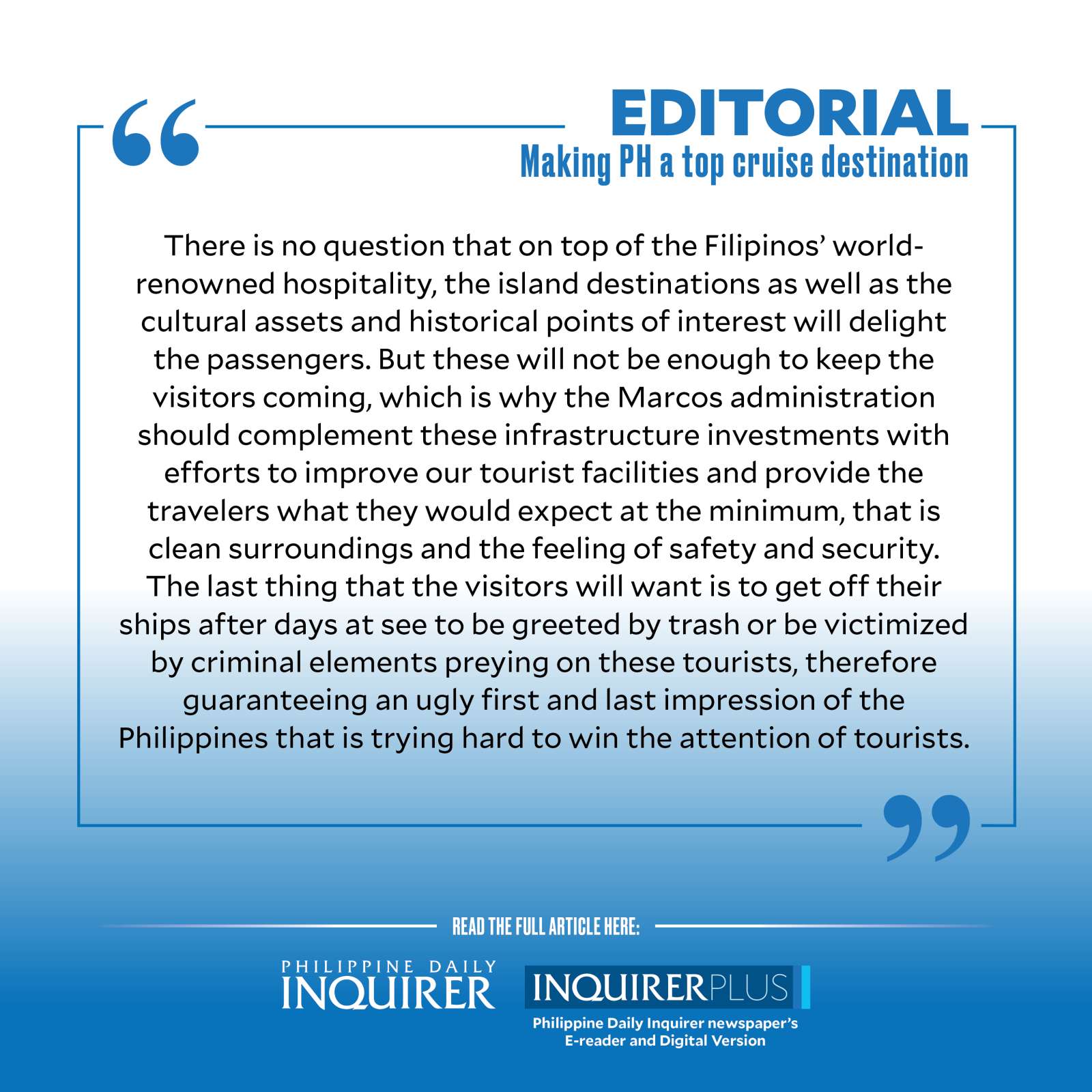
Last Oct. 16, the Philippines bagged for the first time the title of “Best Cruise Destination in Asia” during the prestigious World Cruise Awards in Dubai, United Arab Emirates, beating rivals India, Japan, Singapore, South Korea, Sri Lanka, Taiwan, Thailand, and Vietnam.
Tourism Secretary Christina Garcia-Frasco was rightfully ecstatic about the unexpected award, describing it as a “big win for Philippine tourism as it reflects a resounding global preference for our island destinations.”
Indeed, the award is nothing to sneeze at as the World Cruise Awards is considered the most prestigious awards program in the cruise tourism industry and celebrates and rewards excellence in cruise tourism.
To help ensure that the award is not a mere fluke, the Department of Tourism has committed to implement its action plan to take advantage of the growing interest in the Philippines among cruise travelers, who had been yearning to explore the world aboard luxurious cruise ships after being forced to coop up by the COVID-19 pandemic travel restrictions.The vision under the National Cruise Tourism Development Strategy and Action Plan is to make the Philippines “an attractive and diverse cruise destination, offering high levels of customer satisfaction and cost-effective deployment for cruise lines operating from major home ports in Asia” by delivering “excellent” guest experiences.
Investing in the cruise industry should be a worthy investment as cruise travelers are said to be big spenders to the tune of about $100 a head for every time they make a call to port. In 2019, before the COVID-19 pandemic hit, cruise ships brought in 213,765 passengers to the Philippines.It is heartening to note that the Philippine Ports Authority (PPA) will contribute its share to developing cruise tourism in the Philippines and keep the title of best cruise destination in Asia with the development of five new terminals at tourism centers Boracay, Coron, Camiguin, Siargao, and Puerto Galera that can accommodate the large ships.These new terminals will be a much welcome addition to the five ports currently in operation—Curimao in Ilocos Norte, Salomague in Ilocos Sur, Manila, El Nido in Palawan, and Tagbilaran in Bohol where, as pointed out by PPA general manager Jay Santiago, tourists experience the rich culture, desirable local delicacies, and the warmth of the Filipino people.Expanding the list to cover more ports across the country would be a crucial step to give global cruise lines more reasons to add the Philippines to their itinerary, especially with its profile rising following the award.
The government projects that the Philippines will have 128 ports of call or cruise calls in 2023 across 33 destinations in the country.
Santiago estimates that in the last quarter of this year alone, more than 40,000 tourists will visit the Philippines via cruise ships by industry giants such as AIDA Cruises, Holland America Line, Norwegian Cruise Line, Silversea Cruises, and Windstar Cruises. They will add to the 46,657 passengers from ships calling at its ports from February to September this year.Frasco underscored the importance of the cruise tourism sector as this does not mean just additional tourists contributing revenue to government coffers. As early as February when cruise tourism resumed in the Philippines, Frasco said that the plan was to develop the Philippines “as a major regional cruise center in Asia that supplies not only cruise ship experiences but also crew training, crewing, cruise line business outsourcing, and cruise ship maintenance services in Asia.”
Just as important is the continued employment of hundreds of thousands of Filipinos working on cruise ships. In the first three cruise lines that arrived in the country, Frasco said Filipino seafarers and tourism frontliners made up about half of the staff. Other lines should show the same ratio given the dominance of Filipinos in the seafaring community. The international cruise ships are expected to bring some 101,000 passengers and about 50,000 crew and staff that will explore what the Philippines has to offer. There is no question that on top of the Filipinos’ world-renowned hospitality, the island destinations as well as the cultural assets and historical points of interest will delight the passengers.
But these will not be enough to keep the visitors coming, which is why the Marcos administration should complement these infrastructure investments with efforts to improve our tourist facilities and provide the travelers what they would expect at the minimum, that is clean surroundings and the feeling of safety and security.
The last thing that the visitors will want is to get off their ships after days at sea to be greeted by trash or be victimized by criminal elements preying on these tourists, therefore guaranteeing an ugly first and last impression of the Philippines that is trying hard to win the attention of tourists. By zeroing in on these basics, visitors will then be able to see and feel for themselves the reasons why the Philippines won and indeed deserved the title.